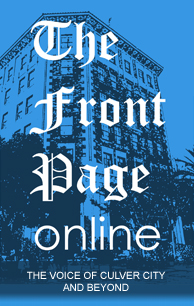[img]7|left|||no_popup[/img] “Doomsday Kiss” is an often funny, sometimes moving, always impeccably performed riff on the end of the world in varying degrees of eccentricity. The Bootleg Theater, an intimate theatre space in which seating and stage spill into each other, is itself something of a DIY apocalypse – in a good way. Red brick and pale plywood walls, jury-rigged fixtures, a warehouse atmosphere that keeps alive the theatre building’s previous incarnation as a bra factory – it’s an anti-aesthetic aesthetic that’s not only hip but sets the right tone for “Doomsday Kiss,” a slack gestalt of four theatrical works. Artwork in the lobby aims to prep audiences with an apocalyptic mindset, but the domesticated imagery of mushroom clouds and gas mask ultimately highlights what “Doomsday Kiss” is not; topical. No dire warnings of global warming-related catastrophes nor scenarios of water scarcity or economic collapse; not even that old standby, the fear of nuclear annihilation. There’s a hint of the latter, of course, a background picture involving a mysterious death cloud – or something that puts a second sun in the sky – that permeates all but one of the four pieces. For the most part, however, the characters in the various “Doomsday Kiss” pieces are in the grips of a purposefully vague apocalypse. The end is here, and it will be generalized.
[img]481|left|||no_popup[/img]From left, Ben Messmer, Alina Phelan, Michael Dunn, Babar Peerzada and Jessica Hanna
The production starts out with “Who Is Randall Maxit?,” a piece focused on the titular character and his relationship with the end of world. Gray Palmer plays him as part guilty conscience and part mad scientist, a quirky blend that inevitably includes a bit of megalomania in the mix. As the connective tissue woven in between the other plays, the four-part “Who Is Randall Maxit?” has to work to keep its own momentum going while simultaneously framing the other pieces. Although Maxit still ends up something of a mystery by the end — the idea of an Oppenheimer-like figure often overwhelms the character’s psychology — playwright Clay Hazelwood’s contribution does build an eerie suspense around a man whose mind is seemingly lost to drug-induced talk show trials and surprising physical symptoms.
For Fans of Quirkiness
The impression that Doomsday Kiss might be a little too content skimming the surface continues with Sharon Yablon’s “You Might Be Waking Up,” a post-apocalyptic survivor drama with a high quirk-to-pathos ratio. Set in a business park gone more or less feral – the office space gone wild – the piece takes on the comedy and tragedy of people sorting out what comes after the end of life as we know it. From regrets over botched opportunities to midlife confrontations with the ravages of time, the characters of “You Might Be Waking Up” humanly struggle with the fact that a changed world means, by necessity, that the past has gone out of reach.
Confronting the end more directly is, arguably, the one play of the “Doomsday Kiss” quartet that could sustain a performance on its own, Eva Anderson’s “Fun Days At Sea.” The scenario is grim; a cruise ship sailing the wide-open waters in a futile attempt to escape a deadly cloud, gradually using up supplies and hope. Different perspectives are embodied in the characters, from a strained hedonistic indifference to utter despair (and a few in between), and the whole piece is the closest to an elegy that “Doomsday Kiss” has to offer.
Surprisingly, there is a sexual subtext to “You Might Be Waking Up” and “Fun Days At Seas” – ranging from frustrated sexuality to the off-stage influence of post-apocalyptic lesbians on the third floor of an office building – that culminates in “The Class Room,” the piece most removed from the apocalyptic thread running through the production. Which isn’t to say that the end of the world isn’t a topic for Wesley Walker’s piece, but that where the apocalypse is a physical, loosely connected event in the other three pieces, it is a disconnected psychological one in “The Class Room.” The narrative, what plot there is, concerns a reporter investigating the apparent success of Dr. V in subduing children – “quelling” them. But in a manner that brings to mind Lewis Black’s obliquely funny “The Deal,” “The Classroom” becomes deliciously bizarre and rather defiant of conventional interpretation. It’s like a crypto-absurdist Freudian romp through psychoanalytic end times in which the fear of castration bumps up against the death-instinct amidst the strange collision of masculinity and femininity. Freud hasn’t been genuinely provocative for a long time, but Walker does manage to build on the old fraud’s ideas to surprise just as much as he baffles.
Surprise and baffle – really is as good of a summation as any of “Doomsday Kiss” in its entirety.
Doomsday Kiss. Produce by REPO Division and the Bootleg Theater. Art installation curated by Sandy Rodriguez; four interwoven plays by Eva Anderson, Clay Hazelwood, Wesley Walker and Sharon Yablon. For tickets and information, call 213. 389. 3856 or visit www.bootlegtheater.com
Frédérik invites you to discuss “Doomsday Kiss” and more at his blog.
